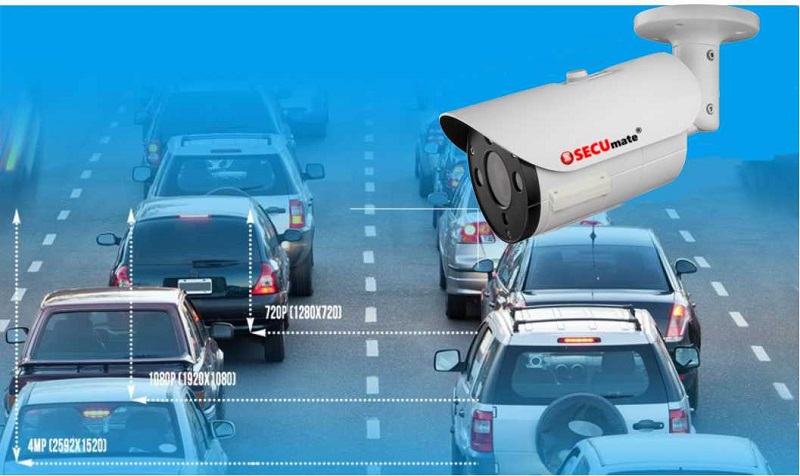After the analog HD cameras (AHD, CVI, TVI, SDI) are able to deliver Full HD 1080p video, 720p & 1080p IP cameras are losing its shine in terms of image quality. In order to catch up the trend, 4-megapixel IP cameras come into market. According to the IPVM (researching firm), 4MP cameras are an important emerging trend in video surveillance, aiming to replace 1080p. In this article, we intend to offer the comprehensive information about the 4MP IP cameras and the its differences compared with the 1080p IP cameras.

1# What’s the 4-megapixel resolution?
Currently, there is no standard format for 4-megapixel resolution. Most 4MP IP cameras can deliver 4MP video has 2688 (Wide) x 1520 (Height) pixels. Because these cameras are based on 1/3-inch 4MP CMOS image sensors from OmniVision. The OmniVision next generation 4MP CMOS image sensors are able to capture 2688 x 1520 pixels video at max. 90 fps.
Compared with 1080p/2-megapixel, that’s two times more detailed than Full HD 1080p. The same with the 1080p resolution, 4MP resolution keeps the 16:9 video aspect ratio which allows it perfectly fit the HDTV, and the future Ultra HDTV widescreen displaying. Unlike 3MP & 5MP, they maintain 4:3 aspect ratio that is not compatible with HDTV standard.
4MP Surveillance Video: Maintaining 16:9 aspect ratio
3MP Surveillance Video: Maintaining 4:3 aspect ratio
2# 4MP vs 1080p
The 4-megapixel image has twice the detail of the 1080p image (4 MP vs. 2 MP), meanwhile the cost of 4-megapixel IP cameras is just little higher than 1080p IP cameras. Obviously, many users incline to select 4-megapixel cameras. However, by increasing the image resolution, the required network bandwidth and storage will increase accordingly.
Pros of 4MP:Higher resolution, two times more detailed than Full HD 1080pMaintaining 16:9 aspect ratio Supported by HDTV display Cons of 4MP:Two times larger requirement of bandwidth and video storage space Requiring higher performance devices (HDTV display, NVR) to decode Higher cost of equipment (including front-end & back-end devices)Low light performance is not as good as its counterpart 1080p3# Is the 4MP H.265 IP Camera really worth trying?
Thanks to the next generation video compression technology – H.265/HEVC. From H.265 whitepaper, by utilizing the H.265 compression, the file size of video stream can reduce 50%, consequently save 50% network bandwidth and video storage space.
Although H.265 seems so promising, the H.265 video stream still can’t be supported by current web browsers and multimedia players. In order to test the H.265 IP camera, we mounted a 2MP H.265 camera in the DSLR camera tripod, then we accessed the camera through its web interface.
After switching the default H.264 video compression to H.265, the video previewing and replaying encounter distortion problem on its web interface. Although VLC media player can recognize and play the H.265 video files, they can’t be decoded correctly, that means you have to use the H.265 network video recorders to record and decode the H.265/HEVC video from security network cameras.
3# Frame per second
A real 4MP IP camera should deliver the video stream with real-time fps, that’s 25fps (PAL) / 30fps (NTSC). FPS is mainly determined by the encoding capability from the encoding processor. Hi3516D offers maximum 3MP@30fps or 5MP@15fps video encoding capability, while Hi3516A offers 5MP@30fps.
So, a camera that delivers 4MP@25/30fps video is better than a camera only delivers 4MP@20/15fps. However, you may notice many current 4MP IP cameras don’t deliver real-time 4MP resolution. Video playing at 30fps, 20fps, 15fps, people can’t notice the difference (unless slow down the video). Replaying and recording between 15 and 20 frames per second is very common. This is because very little quality is lost. When you carefully read the specification of Dahua/Hikvision 4MP IP Cameras, you may realize these cameras produce 4MP@20fps / 3MP@25/30fps video.
4# 4-megapixel equals what tvl
This a common question people usually ask us, especially for those are familiar with analog CCTV system. Although digital/IP surveillance systems use pixels to measure the resolution, the resolution still can be measured by television lines. ASMAG magazine has conducted the resolution test for multiple IP cameras. In summary, 720p (1.0MP) equals to approximate 750 TVL, 1080p (2MP) equals to approx. 900 – 1100 TVL, 4MP equals to approx. 1400 – 1500 TVL, 5MP resolution equals to 1600 TVL, 4K equals to over 2000TVL.
5# 4-megapixel IP camera solution
As we mentioned in previous paragraph, most 4-megapixel network cameras utilize the OmniVision 4MP CMOS image sensors. OmniVision offers a complete 4MP product portfolio covers the regular (OV4689), low-light (OV4688) and WDR (OV4685) models. In terms of video encoding solution, Hisilicon and Ambarella solutions predominated in today’s market. Hisilicon has Hi3516D (3MP@30fps; 4/5MP@15fps) and Hi3516A (4/5MP@30fps), while Ambarella S2L owns 5MP@30fps video encoding capability, S3L offers 4/5MP@30fps and S3Lm provides 3MP@30fps or 4MP@20fps. Likely the current selling Hikvision/Dahua 4-megapixel IP cameras adopt the OmniVision + S3Lm hardware design.

